Description
A light loving orchid, it is a small, cool growing epiphyte reaching 40 cm in height with conical, ovoid to pear shaped, longitudinally grooved, 2.5 to 4.0 cm in length and 1.5 to 2.5 cm in width pseudobulbs that are enveloped completely by imbricate, persistent, papery sheaths and carrying 2, oblong-lanceolate, acuminate, lean, 5-15 cm long and 3 cm wide leaves.
Inflorescence
Flowering occurs in summer by means, with spikes protruding from the top of a mature pseudobulb. These carry one to four 4 to 6 cm flowers that open at the same time, last around 7 days, are not very fragrant, have a waxy consistency and are cream colored. The sepals are lanceolate, wider than the petals, which tend to curl backwards. The labellum is hairy and trilobed with raised lateral lobes and has yellow and dark red spots.
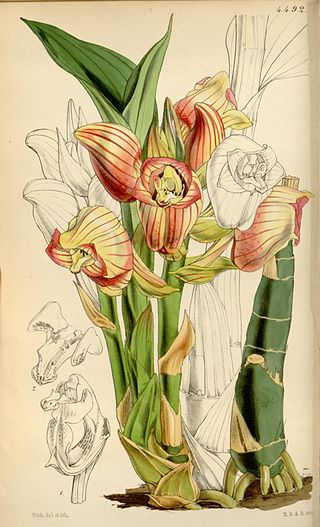
Acanthophippium is a genus of orchid with thirteen species. The name of this genus is derived from the Greek words acanthos ("spiny") and ephippion ("saddle"), referring to the saddle-like labellum of the plants.

Anguloa, commonly known as tulip orchids, is a small orchid genus closely related to Lycaste. Its abbreviation in horticulture is Ang. This genus was described by José Antonio Pavón and Hipólito Ruiz López in 1798. They named it in honor of Francisco de Angulo, Director-General of Mines of Spain.

Ancistrochilus is a genus of the orchid family (Orchidaceae), comprising only 2 species.

Ansellia is considered a monotypic genus of orchid, with only one species, Ansellia africana, commonly known as African ansellia or leopard orchid, however, it may in fact be a complex group of species which share common floral structure and growth habit.

Dendrobium kingianum, commonly known as the pink rock orchid, is a flowering plant in the orchid family Orchidaceae and is endemic to eastern Australia. It usually grows on rocks, rarely as an epiphyte, and has thin, spreading leaves and spikes of up to fifteen, usually pink flowers in late winter to spring. It is popular in Australian native horticulture and is a commonly cultivated orchid among Australian orchid species growers.

Hammarbya paludosa is a small orchid commonly known as bog orchid, bog adder's-mouth or bog adder's-mouth orchid. It grows in bogs in temperate and subarctic regions of the Northern Hemisphere.

Crinum asiaticum, commonly known as poison bulb, giant crinum lily, grand crinum lily, or spider lily, is a plant species widely planted in many warmer regions as an ornamental. It is a bulb-forming perennial producing an umbel of large, showy flowers that are prized by gardeners. However, all parts of the plant are poisonous if ingested. Some reports indicate exposure to the sap may cause skin irritation.

Ancistrochilus rothschildianus is a small species of semi-terrestrial, orchid endemic to the African tropics. A. rothschildianus is cultivated for its "pretty pink flowers." This species and Ancistrochilus thomsonianus are the only recognized species in genus Ancistrochilus.

Cattleya maxima is a species of orchid in subfamily Epidendroideae found from Ecuador to Peru.

Coelogyne barbata is a species of orchid. It is a shade-loving orchid that blooms in the months of October–November. It occurs in the Himalayas, Nepal, India, China and Myanmar. It grows epiphytic on trees or lithophyte on rocks in lower montane forests at an altitude of 1000 to 1800 meters above sea level. It is also found in Phalee but is rare. It has long, broad leaves and a bulb stem that grows from the roots. It blooms in September- November. It's a shade loving orchid.

Coelogyne flaccida is a species of orchid that is native to southeast Asia and northeastern South Asia. Cultivated as an ornamental plant, it is also known as the bearded coelogyne and the loose coelogyne.
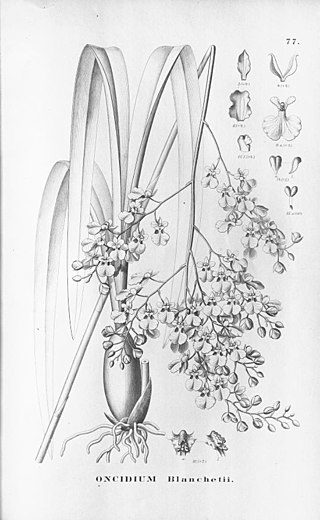
Oncidium blanchetii is a species of orchid native to eastern and southern Brazil. Found in the cool mountains, hot and humid lowlands and inland savannahs of eastern and southeastern Brazil as a medium-sized, cool growing epiphyte that occurs at elevations of 800 to 2000 meters with clustered, erect, oblong or narrowly ovoid-oblong, compressed, smooth and then sulcate with age pseudobulbs carrying 3 apical, erect, rigid, coriaceous, narrowly linear-ligulate, acute leaves and blooms in the spring through summer on an erect, 2' to 5'4"" long, robust, paniculate, many flowered inflorescence that is longer than the leaves and has concave, lanceolate bracts.

Spathoglottis plicata, commonly known as the Philippine ground orchid, or large purple orchid is an evergreen, terrestrial plant with crowded pseudobulbs, three or four large, pleated leaves and up to forty resupinate, pink to purple flowers. It is found from tropical and subtropical Asia to Australia and the western Pacific including Tonga and Samoa.
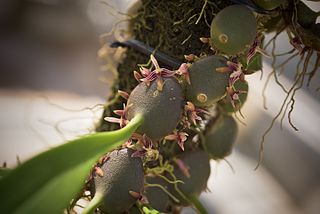
Bulbophyllum cruciatum is a species of orchid in the genus Bulbophyllum found in Papua, Papua New Guinea, Seram Island, and Maluku Islands.

Epidendrum sophronitisLinden & Rchb.f. (1857) is a small Epidendrum orchid that bears a superficial resemblance to a Sophronitis, as the generic epithet was used prior to the year 2000.

Psychopsiella is a monotypic genus in the orchid family found only in the state of Rio de Janeiro in Brazil and near Caracas in Venezuela. It grows as an epiphyte in evergreen montane forests at elevations of 800 to 1,500 metres.

Phaius tankervilleaevar.australis, also known as the common swamp orchid, southern swamp-orchid, swamp lily or island swamp-orchid, is a species of orchid endemic to eastern Australia. It is an evergreen, terrestrial herb with large, crowded pseudobulbs, large pleated leaves and flowers that are reddish brown on the inside and white outside.
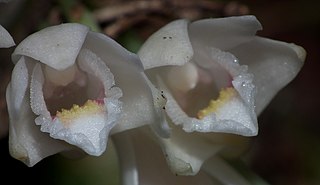
Dendrobium milaniae is flower of the Orchid family found in Leyte, Visayas in the Philippines, where it is found growing as an epiphyte above bodies of water at elevations up to 600 metres. The flower grows to approximately 1.5 centimetres (0.59 in). The plant is semi-pendulous and sympodial. Pseudobulbs are 10 cm by 2 cm; 3 to 6 green lanceolate leaves are present on the top third of the pseudobulb. Hans Fessel and Emil Lückel named this species in 1996 in Die Orchidee.
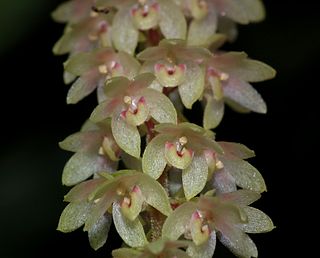
Pinalia polyura, or many-tailed pinalia, is a member of the orchid family endemic to the Philippines. It is semi-pendulous and sympodial, with pseudobulbs that are 20 cm long, 1 cm in diameter, and somewhat club shaped. Each new growth begins halfway along the previous year's pseudobulbs, making the plant longer each year. Each pseudobulb has about 5 shiny, lanceolate leaves approximately 15 cm long and 2 cm wide. Inflorescences appear at the upper portion of the plant and are pendulous, about 10 cm long and bear up to 40 flowers each 1.5 cm in diameter. It grows as an epiphyte and sometimes as a semi-terrestrial plant at elevations to 2,400 meters.

Maxillaria obtusa, synonym Trigonidium obtusum, is an orchid native to tropical South America.




















